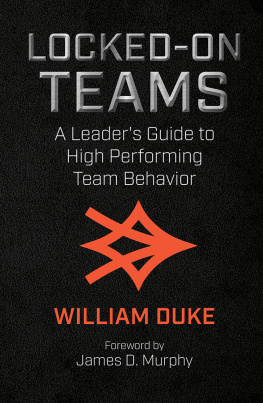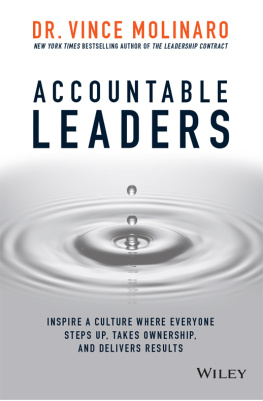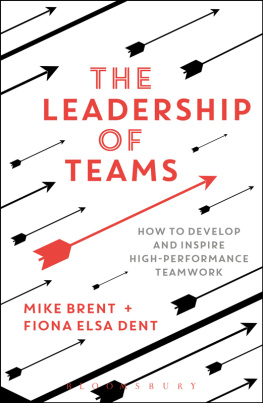Locked-On Teams
A Leaders Guide to High Performing Team Behavior
With Forward by James D. Murphy
William Duke
ISBN (Print Edition): 978-1-54397-956-5
ISBN (eBook Edition): 978-1-54397-957-2
2019. All rights reserved. No part of this publication may be reproduced, distributed, or transmitted in any form or by any means, including photocopying, recording, or other electronic or mechanical methods, without the prior written permission of the publisher, except in the case of brief quotations embodied in critical reviews and certain other noncommercial uses permitted by copyright law.
Foreword
L eadership. The word conjures up much emotion and visions of moving masses to great victories- overcoming enormous challenges and conquering a great goal. But, how does the word leadership help you? Especially now, in todays ever-connected, complex world of business?
Changes and pivots required in business today overwhelm old-school notions of leadership that direct people toward goals planned out in the C-suite. The industrial age of centralized planning and command-and-control hierarchies is in its twilight almost, but not quite gone. Younger generations in the work force today expect more collegiality, collaboration, feedback and flexibility than the leadership styles of the previous century demanded.
It takes bold leaders to design, inspire, and align to create the future we all seek. Leaders that can see the future clearly and develop pulling rather than pushing mechanisms to get people, process, and technology aligned to move forward is the key to effective leadership in this new age.
If you are like most of my clients, you are struggling to identify good leadership practices and scale them throughout your whole organization. In the following pages you will realize that leadership is a lifelong, intentional journey, one that will require patience and effort. Whether you are young and taking up the mantle of leadership for the first time or a seasoned leader with many years of experience, fundamentals are always important to reflect upon and implement with sound judgment. Youll find those fundamentals within this book.
Leading a team through a challenge and then reaping the rewards of that collective effort can be one of the most satisfying and meaningful experiences of your life. I remember the first true leadership challenges and issues I undertook in my military and business careers, challenges that seem very similar to the ones I continue to take on today. Developing and holding myself to a standard; having the discipline to model that standard myself; and trusting others to execute those standards with integrity have been essential to my success, my teams success, and the success of the organizations Ive led. Friendships are part of business, but as a leader the standard always wins - doing whats right and staying the course will test the best leaders. I know it has and will continue to test me.
In my military career I learned that transformation must occur in you and your team if you are going to lead and improve. I went from farm-boy to fighter pilot in sixteen months! Did the U.S. Air Force have to transform me and others? Yes and it had to do it quickly in order to survive, thrive and dominate in our environment. That intentional process of transformation was, and still is, the key to success in military organizations around the world. Yes, leadership can be learned. The fundamentals of leadership are a set of interconnected patterns, processes, and techniques that can be scaled throughout an organization. However, theres no one-size-fits-all prescription that leaders may follow.
Leadership is a quest - a personal quest that you get excited about, that you dedicate real effort and mental focus to in every aspect of your daily life. Your own family will be a testing ground so will your friendships. Youll find that many of the principles laid out in this book can be just as important in your personal and family life as they are in your work life. To truly become a leader, your skills must come from the deepest part of you day in and day out. Real leadership never takes a break or a vacation at work, home or at play! When you truly become a leader, everyone knows it. Its not a title you earn or throw on your shoulder. Its who you really are. Be proud of your leadership quest, it will shape you for the better, every day.
In the following pages William M. Duke will lay out the why, what, and how of leadership. The guidance within is built upon science, the experience of successful leaders, and the results of many years of practice and implementation. The principles and guidelines herein are not just based on our own personal leadership journeys, but upon those of thousands of client engagements that my team at Afterburner has worked through for over twenty years - leadership lessons and challenges the best CEOs, EVPs, Managers and Entrepreneurs have encountered. The lessons we have learned come from our clients in tech, retail, manufacturing, healthcare, and countless other sectors of business and even professional sports. This recipe for success is not just another leadership manifesto, its real boots and leather experiences honed by elite military leaders applied and redeveloped in the halls of corporations and successful teams. You have in your hand the blueprints to your own effective leadership system. Strap-in! This leadership ride will pull you to the next level.
James D. Murphy
Introduction
T here is no consensus among leadership scholars and practitioners on how best to define leadership. However, that should come as no surprise to those who have thought conscientiously about the subject. The effort to define leadership is meaningful. Its a philosophical struggle for those seeking to understand their place and responsibilities as leaders. For most, leadership does not become a subject of interest until one finds oneself in a leadership position. For such novicesand for experienced leaders alikethis book assembles the fundamentals of leading high-performing teams in a single, easily accessible resource.
The consensus on the definition of leadership rests on two characteristics influencing and goal-setting . If a group of people already want to achieve a shared goal, that is best. If not, then leadership gets really tough. If the goals are counter to what the group wants or believes is right, then one may question if it is not coercion rather than leadership that is needed; power and control rather than influence and aspiration.
The fact that leadership resists simple definition despite the thousands upon thousands of books on the subject should not come as a surprise to those that have genuinely struggled to understand their role as a leader. That is because leadership, for good or ill, is about affecting . To affect others means to influence them emotionally. Many leaders throughout history have led without any formal power such as Martin Luther King Jr. or Mahatma Gandhi. Often, they embodied a popular idea or desire and provided a focal point for the aspirations of many.
However, this book is not about leading or taming the colossal forces of transformative change at work today. This book isnt even about the transcendent and unchanging fundamental principles of leadership across the vast canvass of human history. Instead, this book is for those who find themselves, either by chance or by choice, functioning as a leader of a team in any organization. But whats more, it is for leaders today, here in the early 21 st century, because circumstances change and societies evolve. Most leaders todaywhether in a small start-up, a large corporation, a non-profit, a government agency, or even in the militarylead teams in a modern and mostly democratic knowledge economy. Historically, that is a different context than, say, leading a phalanx of Spartan warriors against an overwhelming Persian invasion at the Gates of Thermopylae almost 2500 years ago. It is also different from leading a Dutch East-India company trade expedition to Formosa in the 17 century. It is different from running a Ford Motor company factory in Detroit producing Model Ts in 1920, and it will probably be different from leading any sort of organization in the early 22 nd Century as well.









